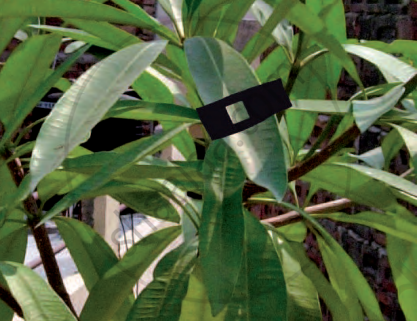Advertisements
Online Mock Tests
Chapters
2: Nutrition in Animals
3: Heat
4: Acids, Bases and Salts
5: Physical and Chemical Changes
6: Respiration in Organisms
7: Transportation in Animals and Plants
8: Reproduction in Plants
9: Motion and Time
10: Electric Current and Its Effects
11: Light
12: Forests: Our Lifeline
13: Wastewater Story
![NCERT solutions for Science [English] Class 7 chapter 1 - Nutrition in Plants NCERT solutions for Science [English] Class 7 chapter 1 - Nutrition in Plants - Shaalaa.com](/images/science-english-class-7_6:325736d0fe154a27901a6745284d30d9.jpg)
Advertisements
Solutions for Chapter 1: Nutrition in Plants
Below listed, you can find solutions for Chapter 1 of CBSE NCERT for Science [English] Class 7.
NCERT solutions for Science [English] Class 7 1 Nutrition in Plants Exercise [Pages 9 - 10]
Why do organisms need to take food?
Distinguish between a parasite and a saprotroph.
How would you test the presence of starch in leaves?
Give a brief description of the process of synthesis of food in green plants.
Show with the help of a sketch that the plants are the ultimate source of food.
Fill in the blanks:
Green plants are called ______ since they synthesise their own food.
The food synthesised by the plants is stored as ______.
In photosynthesis, solar energy is absorbed by the pigment called ______.
During photosynthesis plants take in ______ and release ______ gas.
Name the following:
A parasitic plant with yellow, slender and tubular stem.
Name the following:
A plant that is partially autotrophic.
Name the following:
The pores through which leaves exchange gases.
Choose the correct answer:
Amarbel is an example of ______.
autotroph
parasite
saprotroph
host
The plant which traps and feeds on insects is ______.
Cuscuta
China rose
Pitcher plant
Rose
Match the items given in Column I with those in Column II:
| Column I | Column II |
| Chlorophyll | Bacteria |
| Nitrogen | Heterotrophs |
| Amarbel | Pitcher plant |
| Animals | Leaf |
| Insects | Parasite |
Choose the true and false statement from the following statements:
Carbon dioxide is released during photosynthesis.
True
False
Plants which synthesise their food themselves are called saprotrophs.
True
False
The product of photosynthesis is not a protein.
True
False
Solar energy is converted into chemical energy during photosynthesis.
True
False
Choose the correct option from the following:
Which part of the plant takes in carbon dioxide from the air for photosynthesis?
Root hair
Stomata
Leaf veins
Petals
Choose the correct option from the following:
Plants take carbon dioxide from the atmosphere mainly through their:
Roots
Stem
Flowers
Leaves
Why do farmers grow many fruits and vegetable crops inside large greenhouses? What are the advantages to the farmers?
NCERT solutions for Science [English] Class 7 1 Nutrition in Plants Activities and Projects [Page 10]
Extended Learning — Activities and Projects
Take a potted plant with broad leaves. Take two strips of black paper and cut out a small square in the centres. Cover a part of two leaves with these papers and secure them with paper clips Figure. Keep the plant in sunlight for 2–5 days. Observe the difference in the colour of the covered and the uncovered portions on the leaf. Perform iodine test on this leaf. Did the two parts show different results? Now take second leaf. Remove the strip and expose the covered part to the sunlight for 2–3 days and do the iodine test again. Describe your observations.

Visit a green house if there is one near your place. Observe how they grow plants. Find out how they regulate the amount of light, water and carbon dioxide to grow the plants.
Try growing a sweet potato just in water. Describe your experiment and observations.
Solutions for 1: Nutrition in Plants
![NCERT solutions for Science [English] Class 7 chapter 1 - Nutrition in Plants NCERT solutions for Science [English] Class 7 chapter 1 - Nutrition in Plants - Shaalaa.com](/images/science-english-class-7_6:325736d0fe154a27901a6745284d30d9.jpg)
NCERT solutions for Science [English] Class 7 chapter 1 - Nutrition in Plants
Shaalaa.com has the CBSE Mathematics Science [English] Class 7 CBSE solutions in a manner that help students grasp basic concepts better and faster. The detailed, step-by-step solutions will help you understand the concepts better and clarify any confusion. NCERT solutions for Mathematics Science [English] Class 7 CBSE 1 (Nutrition in Plants) include all questions with answers and detailed explanations. This will clear students' doubts about questions and improve their application skills while preparing for board exams.
Further, we at Shaalaa.com provide such solutions so students can prepare for written exams. NCERT textbook solutions can be a core help for self-study and provide excellent self-help guidance for students.
Concepts covered in Science [English] Class 7 chapter 1 Nutrition in Plants are Nutrients and Nutrition, Mode of Nutrition in Plant, Autotrophic Plants, Insectivorous Plants, Symbiotic Plants, Nitrogen Fixation, Methods to Replenish Nutrients in Your Soil, Photosynthesis: Food-Making Process in Plants, Heterotrophic Plants, Saprophytic Plants, Nutrients and Nutrition, Mode of Nutrition in Plant, Autotrophic Plants, Insectivorous Plants, Symbiotic Plants, Nitrogen Fixation, Methods to Replenish Nutrients in Your Soil, Photosynthesis: Food-Making Process in Plants, Heterotrophic Plants, Saprophytic Plants.
Using NCERT Science [English] Class 7 solutions Nutrition in Plants exercise by students is an easy way to prepare for the exams, as they involve solutions arranged chapter-wise and also page-wise. The questions involved in NCERT Solutions are essential questions that can be asked in the final exam. Maximum CBSE Science [English] Class 7 students prefer NCERT Textbook Solutions to score more in exams.
Get the free view of Chapter 1, Nutrition in Plants Science [English] Class 7 additional questions for Mathematics Science [English] Class 7 CBSE, and you can use Shaalaa.com to keep it handy for your exam preparation.
